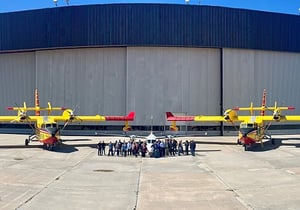Zoo Digital Group PLC (LON:ZOO) Chief Executive Officer Stuart Green caught up with DirectorsTalk for an exclusive interview to discuss their final results and the appointment of a new CFO, Phillip Blundell.
Q1: We saw your finals announced yesterday, can you explain what was the main contributor to the 73% growth that was reported?
A1: Well, there are three segments in which we operate. The first is localisation which is to do with subtitling, captioning and dubbing for the entertainment industry, where we take materials, feature films and TV series from our clients and produce different language versions of those.
The second segment is what we call digital packaging where we prepare video and audio, we put together metadata which is information that’s used, for example, in the programming guides, and we assemble that all together, so those programmes can be delivered through many different channels: streaming platforms as well as on DVD or Blu-ray.
Our third segment is software licencing which is to do with recurring income that comes from mostly legacy software platforms that we’ve developed.
So, in answer to your question, the biggest growth we’ve seen in this period, the year to March 2018, has come from our localisation segment where we’ve seen that revenue line grow by almost 150% in the period. Most of that growth is coming from subtitling which almost doubled in the period and in fact, in the prior two periods it did the same, so we’ve been on an exponential growth in terms of our expansion of services in subtitling.
Also, in the year we just completed, Zoo Digital introduced for the first time dubbing services and as you know, all the services that we provide are delivered using proprietary software that we have created in which we own all the intellectual property rights. This software gives us competitive advantage in the market.
So, we saw our maiden sales through our new dubbing proposition that’s been delivered using our proprietary software.
Q2: You’ve also highlighted some KPIs in this report, can you tell us about those?
A2: We have chosen five KPIs that we’ll report on in each period going forward that we think are the key things to look at in terms of measuring the performance and progress of the business. The first three are financial and the last two are operational.
The first of them is, unsurprisingly, revenue. We report our revenues in US$ and as you pointed out, 2018 saw a 73% growth in sales up to $28.6 million for the year.
The second metric is EBITDA margin and in the period there was actually a decline from 10.8% in 2017 to 8.4% in 2018. The reason for that was the investment that we have been making, and are continuing to make, in order to put the foundations in place that will enable us to yield significant growth opportunities in the future. That’s all part of our investment plan, particularly in the area of dubbing, to equip us so that we can show future growth and we’re confident in being to continue to grow the business in that way.
The third financial KPI is to demonstrate the operational gearing in the business. One of the changes we’ve made in our financial statements this time is the way in which we classify cost of sales. The way we’re showing our P&L statements from this point onwards is that all external direct costs as well as internal direct costs, which are predominantly costs of our staff that are required in order to fulfil client projects, are being categorised as cost of sale. Consequently, what we’re showing now as operational expenditure is truly what you’d call ‘central overheads in the business’. If our business is, as we believe it to be, highly operationally-geared, then you will see that opex expense as a percentage of revenue declining year on year. Over the last 3 years it has declined from 49% in ‘16 to 43% in ’17 and is down to 33% in the year just completed. So, that is all going in the right way and really supporting that assertion that we have a very operationally-geared business.
Of the two operational KPIs, the first measures our capacity to process projects. For us, because of the services that we provide, capacity comes from two components. The first of these is our software platform which is inherently scalable and will enable us to deal with unlimited volume. Because of the nature of the services we offer, there are certain functions that aren’t suited to software automation, most of which are around linguistic-type capabilities such as translation. Because we’re dealing with dialogue, machine translation, which works reasonably well in other areas, does not currently meet the requirements of localisation of dialogue. So, we can’t use machine translation and we have to use human translators. In the area of dubbing, we need to have voice actors in order to voice the roles in different languages.
In both cases those individuals are engaged on a freelance basis. We don’t have those people on staff, and they are available to us through our cloud platforms in a very scalable way, located all around the world. In order to be able to increase capacity, we need to grow that network of freelancers and, over the past 2 years, we’ve doubled the size of that freelancing network year on year. In the year to March ’17, it was just over 2,000 and it increased to well over 4,000 in the year to March ’18. Since the year end, we’ve further increased it to just over 5,000 freelancers. That’s giving an indication of the investment we’re making in building that freelancer network that will give us capacity, enabling us to increase the amount of work that we can process for clients going forward.
Finally, the last of our KPIs is another operational indicator: retained sales. Clearly, our clients include the biggest names in entertainment – major Hollywood studios, the big global providers of streaming and transactional video on-demand services – and we can only maintain those relationships if we’re delivering work of the highest quality. Unfortunately, quality is quite a difficult thing to measure objectively, so as a proxy for that, we’re using retained sales and tracking the proportion of our sales in each year that continue into the next. We’ve consistently shown very high retention levels there – 97% in year ’16 and’17, increasing to 98% in ’18 – indicating the level of satisfaction our clients have with our services.
Q3: Another good piece of news for Zoo Digital was the appointment of Phill Blundell, CFO. Can you tell a little bit about him?
A3: The first thing I would say is that we were very saddened that our CFO of 18 years, Helen Gilder, took a personal decision to move on. She has been a fantastic CFO for the business and we wish her all the best in the future.
We’re very pleased to be welcoming Phill Blundell into the business, who will be joining later this month. Phill has a long track record of success in the public markets in technology. He’s previously been CFO of three AIM-quoted businesses: DotDigital Group plc, Eagle Eye Solutions Group plc and Intelligent Environments plc. He has over 20 years of experience with growth businesses, is a qualified chartered accountant and we believe he’ll be a fantastic asset to the senior management team.


































